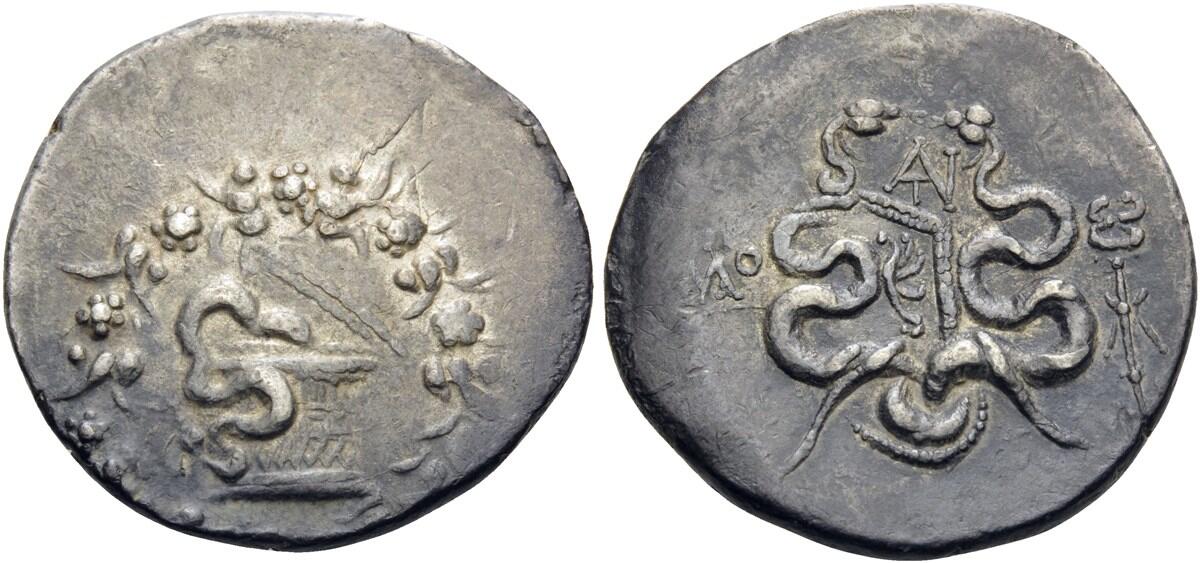S 1731 - Adramyteum, silver, cistophori (125-100 BCE) Carbone
From SILVER
125 BCE - 100 BCE Silver 5,009 kg
Description
| ObverseInscription or printing placed on the obverse.: | Cista mystica from which snake coils, around, ivy wreath with fruits |
| ReverseInscription or printing placed on the reverse.: | Two snakes coiled around a bow case, between the snake heads, monogram, to left, monogram of ΑΔΡ, to right, bunch of grapes |
Mint and issuing power
| MintIdentifies the place of manufacture or issue of a numismatic object.: | Adramyteum | Ancient regionAncient region.: | Mysia | Modern countryModern country: Turkey | AuthorityIdentifies the issuing power. The authority can be "pretended" when the name or the portrait of X is on the coin but he/she was not the issuing power. It can also be "uncertain" when there is no mention of X on the coin but he/she was the issuing power according to the historical sources: | Roman Republic |
Chronology
| FromIdentifies the initial date in a range assigned in a numismatic context. | 125 BCE | toIdentifies the final date in a range assigned in a numismatic context.. | 100 BCE | PeriodTime period of the numismatic object.: Hellenistic 323-30 BC |
Physical description
| MetalThe physical material (usually metal) from which an object is made.: | Silver |
Median weightMedian of the weights of numismatic objects (in grams). in grams | 12.30 | DenominationTerm indicating the value of a numismatic object. Examples: tetradrachm, chalkous, denarius.: | cistophorus |
StandardStandard.: | Cistophoric |
Image

S1731 Laodiceia cistophori.jpg [1]
References
| Die study referencePublication of the study: | Carbone 20201Carbone 2020, p. 178-179 | ||
| Coin series referenceReference to coin series study: | Sear II2Sear II, n° 3800 | ||
Obverse dies distribution
| FrequencyFrequency of specimen in distribution. ᵖ | Number of obversesNumber of obverse dies. ᵖ (o) | % (o) | Number of coinsNumber of coins. (n) | % (n) | Die nameName(s) of the die(s). |
| 1 | 4 | 33.33 | 4 | 17.39 | 2, 6, 7, 12 |
| 2 | 6 | 50 | 12 | 52.17 | 1, 3, 4, 5, 8, 11 |
| 3 | 1 | 8.33 | 3 | 13.04 | 10 |
| 4 | 1 | 8.33 | 4 | 17.39 | 9 |
| Total | 12 of 12 | 99.99 | 23 of 23 | 99.99 |
Reverse dies distribution
no distribution is available
Quantification
| Number of obversesNumber of obverse dies. ᵖ (o) | 12 | Number of singletons (o1)The number of singleton coins. ᵖ | 4 |
| Number of reverse diesNumber of reverse dies. (r) | 21 | Number of coinsNumber of coins. (n) | 23 |
| Coins per obverse dieNumber of coins per obverse die. (n/o) | 1.92 | Coins per reverse dieNumber of coins per reverse die. (n/r) | 1.1 |
| Reverse per obverse ratioRatio of obverse dies divided by reverse dies. (r/o) | 1.75 | Percentage of singletons (o1)number of coins (n) divided by the number of singletons (o1) ᵖ | 33.33 % |
| Original number of dies (O) (Carter 1983 formula)The estimation of the number of coins according to Carter 1983 ᵖ | 20.36 | Coins struck if 20,000 as average productivity per dieCoins made if the average productivity for obverses (according to Carter) is 20,000. ᵖ | 407,200 |
| Original number of dies (O) (Esty 2011 formula)The estimation of the number of coins according to the singleton formula in Esty 2011 ᵖ (O) | 25.09 | Survival rate if 20,000 as average productivity per dieSurvival rate if average productivity is 20,000. ᵖ | 0.00006 |
| Coverage (o = % of O) (Esty 1984 formula)Esty 1984 - coverage (% of O) ᵖ (o = % of O) | 82.61% | Die productivity if survival rate 1/2,000Average productivity if survival rate is 1/2,000. ᵖ | 2,259.33 |
| Weight of silver (in kg) if 20,000 coins per die (O = Carter formula)Carter 1983 * Median weight * 20000 (*10 if gold or electrum) ᵖ | 5,009 kg <br /> 5,009 kg | Die productivity if survival rate 1/5,000Average productivity if survival rate is 1/5,000. ᵖ | 5,648.33 |
Remarks
Most likely one single workstation